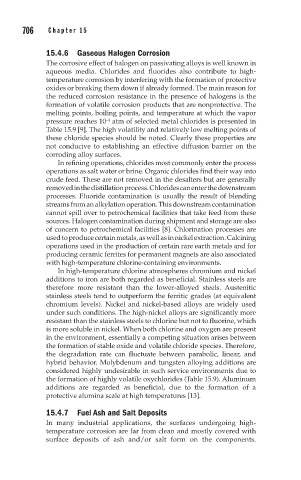Page 755 - Corrosion Engineering Principles and Practice
P. 755
706 C h a p t e r 1 5 H i g h - Te m p e r a t u r e C o r r o s i o n 707
15.4.6 Gaseous Halogen Corrosion
The corrosive effect of halogen on passivating alloys is well known in
aqueous media. Chlorides and fluorides also contribute to high-
temperature corrosion by interfering with the formation of protective
oxides or breaking them down if already formed. The main reason for
the reduced corrosion resistance in the presence of halogens is the
formation of volatile corrosion products that are nonprotective. The
melting points, boiling points, and temperature at which the vapor
pressure reaches 10 atm of selected metal chlorides is presented in
–4
Table 15.9 [9]. The high volatility and relatively low melting points of
these chloride species should be noted. Clearly these properties are
not conducive to establishing an effective diffusion barrier on the
corroding alloy surfaces.
In refining operations, chlorides most commonly enter the process
operations as salt water or brine. Organic chlorides find their way into
crude feed. These are not removed in the desalters but are generally
removed in the distillation process. Chlorides can enter the downstream
processes. Fluoride contamination is usually the result of blending
streams from an alkylation operation. This downstream contamination
cannot spill over to petrochemical facilities that take feed from these
sources. Halogen contamination during shipment and storage are also
of concern to petrochemical facilities [8]. Chlorination processes are
used to produce certain metals, as well as in nickel extraction. Calcining
operations used in the production of certain rare earth metals and for
producing ceramic ferrites for permanent magnets are also associated
with high-temperature chlorine-containing environments.
In high-temperature chlorine atmospheres chromium and nickel
additions to iron are both regarded as beneficial. Stainless steels are
therefore more resistant than the lower-alloyed steels. Austenitic
stainless steels tend to outperform the ferritic grades (at equivalent
chromium levels). Nickel and nickel-based alloys are widely used
under such conditions. The high-nickel alloys are significantly more
resistant than the stainless steels to chlorine but not to fluorine, which
is more soluble in nickel. When both chlorine and oxygen are present
in the environment, essentially a competing situation arises between
the formation of stable oxide and volatile chloride species. Therefore,
the degradation rate can fluctuate between parabolic, linear, and
hybrid behavior. Molybdenum and tungsten alloying additions are
considered highly undesirable in such service environments due to
the formation of highly volatile oxychlorides (Table 15.9). Aluminum
additions are regarded as beneficial, due to the formation of a
protective alumina scale at high temperatures [13].
15.4.7 Fuel Ash and Salt Deposits
In many industrial applications, the surfaces undergoing high-
temperature corrosion are far from clean and mostly covered with
surface deposits of ash and/or salt form on the components.

